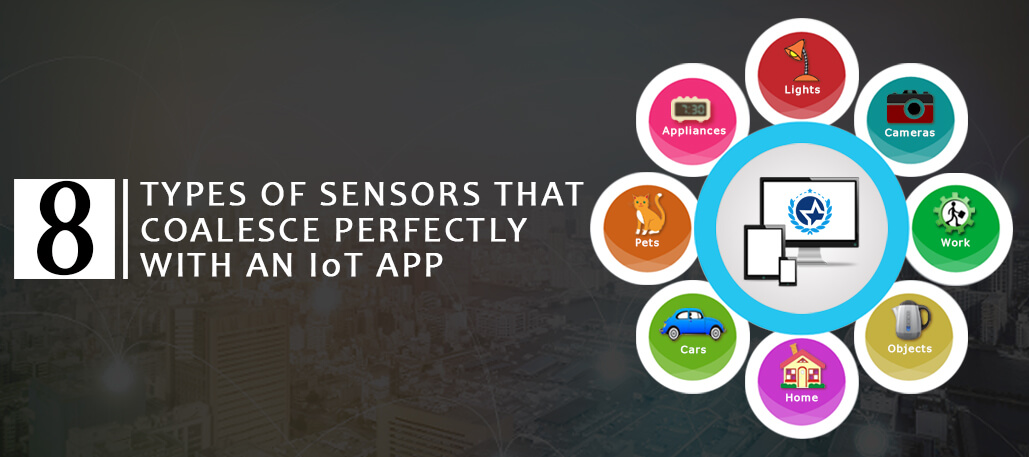
8 Types of Sensors that Coalesce Perfectly with an IoT App
What is that one factor that separates a human from normal living beings? Or what is that one factor that insisted humans to make the machines smarter? Well, it is their curious thinking that made them imagine, experiment and innovate with existing technologies and develop new ones. As roses will never remain same without thorns, likewise an IoT network cannot remain unarmed with sensor troops. Take a look at how various sensors are cockled together in IoT universe:
Bringing as many things as possible into its digital fold, Internet of things scenario is soon going to become a curtain raiser that will embrace all possible fields by 2020. Some cool new ways to detect objects located at a distance, some to detect temperature and pressure, while others to detect motion or gyroscopic moment, humidity, IR level or acceleration. Wow, that’s quite a handful! An increasing number of businesses are adding sensors to all the 4P’s – People, processes, places, and products, to capture and analyze information to make better transparent decisions.
Improve business performance, efficiency and enhance the customer experience in more than one way by integrating sensors into various business operations.
Top app development companies have gradually started realizing the power of sensors. These are the smart and indispensable asset for the Internet of Things applications that have made industries get quick insights to modernize all the processes. The Network of sensors is making every element of the organization smarter with every passing day. These have possibly changed the way we see the world. A simultaneous decrease in cost is becoming the other reason for their higher adoption in IoT landscape.
1. Sensors to Detect Temperature
Temperature sensors detect the highs and lows in temperature, sense, collect and transfer the temperature data to any device from where any action can be initiated according to defined algorithms. Being extremely small, these portable sensors work with just any device be it human or any object.
2. Sensors to Observe Acceleration
The orientation and tilting motion in iPhones were where these sensors were used for the very first time. These detect the changes in the velocity of the object with respect to the earth surface. The inertial navigation system that forms the core of such sensors forms the basis of the functionality of missiles and aircraft, can be used in drones for simulating flights, or as an anti-theft protector when a static object loses its inertia, vibrates or moves from its original place.
3. Sensors to Find Pressure
Such sensors find the variations in pressure and compare them against one standard range of values. Further, these send the data to controlling systems in form of electric signals. These are of much utility in water supply, agriculture, heating system and manufacturing sectors.
4. Sensors to Notice Motion/Direction
It helps in detecting any kind of motion with home, office premises and business organizations. This is the principle behind various intrusion detection systems, house safety gadgets, cameras, computerized door controls. Deciphering various action categories like hand movement, clapping, waving and thus are used in power control gadgets, hand dryers, automatic sinks and parking gadgets etc.
5. Gyroscope
Gyroscope along with accelerometer helps in measuring the angular rotation velocity and detecting linear acceleration. Both these sensors are used in conjunction with various devices and applications.
They come in all sizes, with varied performance, diverged output and environmental conditions etc. Space shuttles, fiber optic, aircraft, race cars, motor boats are other application areas of gyro-sensors. Other variations are vibration gyro sensors with comparatively less sensing capability are largely in use for digital cameras, car navigation, mobile games, SLR cameras and camera shake detection systems.
6. Sensing Proximity
Allowing or restricting an object to be in prescribed proximity, this sensor triggers when it finds something within the prescribed distance. Parking facilities in large departmental stores and airports make extensive use of such sensors so that you are able to find a correct parking place and likewise.
7. Smoke Detection
Emergency alarms that detect smoke or any such threat within the office or home premises signals IoT utility which in turn ships the sign to the attached gadgets to open the evacuation door or ring the emergency bell.
8. Optical Alarm Sensors
Detecting light by help of Fiber optics in surrounding electromagnetic field and then converting it into the form that is easily readable by digital devices, IoT app development companies make use of such sensors find their immense use in photo-detectors, transportation fields, optical switches and elevator doors, as they are immune to the electrical and electromagnetic interference.
